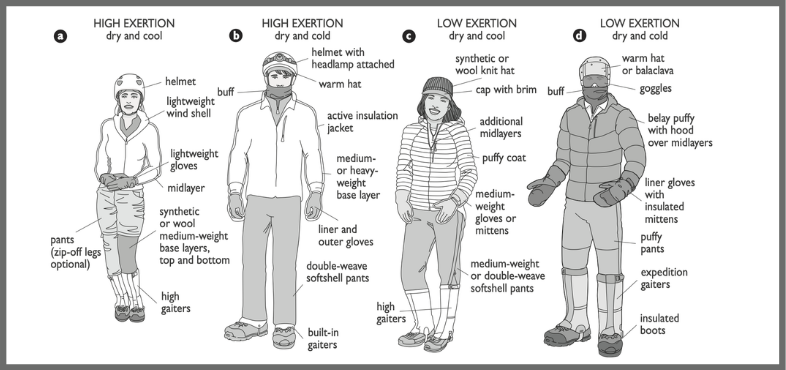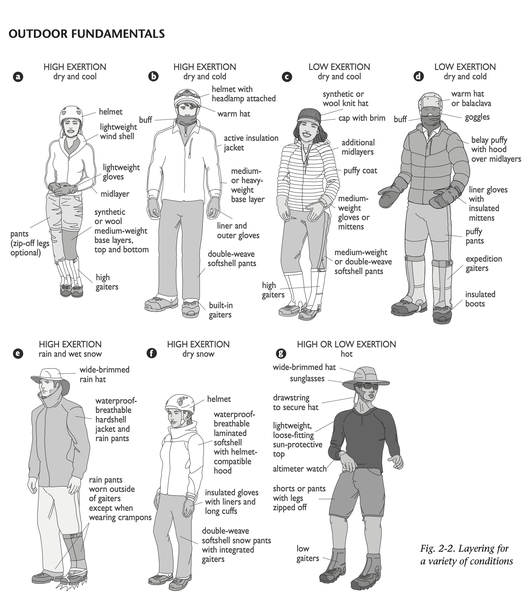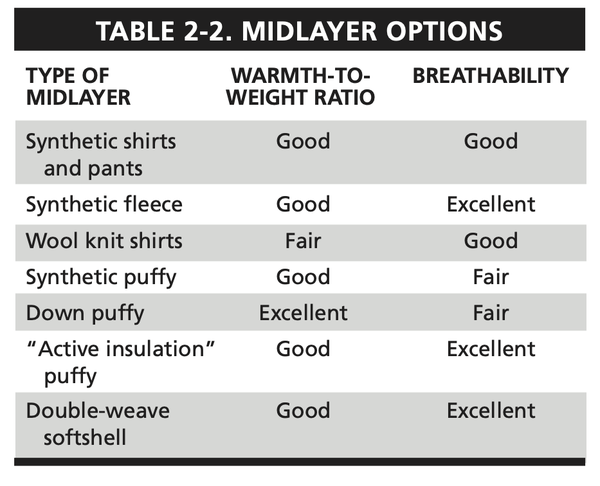
From Chapter 2: Clothing and Equipment of Mountaineering: The Freedom of the Hills, 9th Edition.
LAYERING
Dressing in layers makes it easier to adapt to fluctuating temperatures and conditions in the mountains. The goal is to minimize clothing weight and bulk while efficiently maintaining a comfortable body temperature by removing or adding layers as needed. Experienced mountaineers develop a basic strategy of layering consisting of a few select garments of high functionality, which they use in combination—depending on conditions and personal preference—for most of their activities. They may swap in a new base layer, carry more or fewer midlayers or a different outer garment, or try something new—but the layering system has withstood the test of time and the elements. An outdoor clothing layering system consists of four types of layers:
1. Base layer. The base layer, immediately next to your skin, allows perspiration to evaporate, keeping your skin warm and dry.
2. Midlayer.Midlayerstrapwarmairclosetoyourbody. The thicker the layer of trapped air, the warmer you will be. Although less efficient than a single, monolithic block of “dead” air (as in a down parka, for example), several light, loosely fitting layers can trap a lot of insulating air, and such an arrangement is very adjustable.
3. Shell layer. Shells protect midlayers from wind and precipitation. These could be waterproof-breathable hardshells, softshells, or wind shells, depending on conditions.
4. Belay jacket. Donned quickly when you stop moving in cold conditions, an insulated jacket sized to fit over everything can preserve hard-won warmth.

Think of layers as a system intended to maintain comfort in a wide variety of mountain weather, or worn all at once to survive an unplanned bivouac. Try the layers on together before you commit to the complete system for a climb to make sure the shell layer fits comfortably over all the midlayers without compressing insulation or restricting movement.
PUTTING TOGETHER A LAYERING SYSTEM— FROM THE SKIN-SIDE OUT
Armed with knowledge of outdoor fabric characteristics and the strategy of layering, you can assemble an effective mountaineering clothing layering system. Figure 2-2 shows how various articles in a complete clothing system are mixed and matched to function throughout a spectrum of weather conditions and different levels of physical exertion. The exact garments chosen will vary significantly from climber to climber. The goal is to create a flexible system that keeps you safe. Following are some specific guidelines for particular mountaineering conditions.

Cool conditions with rain or wet snow are the most difficult to prepare for. Waterproof-breathable garments are the best available, but condensation will still form under them during exertion. Dress minimally underneath to avoid overheating, vent as much as possible, and assume the clothes you are wearing underneath are going to get wet. Wear gaiters under rain pants. A rain kilt or poncho is an option for the approach hike. Colder conditions and precipitation in the form of snow is a bit simpler to dress for than rain. Cold snow will sluff off garments before it has a chance to melt. Waterproof-breathable garments do not breathe as well as other outer layers; more-breathable softshells (either laminated or waterproof-breathable laminated) may be sufficient.
Closely monitor your personal temperature levels. To avoid overheating, vent as much as possible and adjust layers as needed. Try to start off feeling a bit cool to avoid overheating as you exert more energy and warm up. Remove waterproof-breathable garments as soon as possible. For resting, belaying, or in camp, waterproof-breathable garments are at their best, when both exertion and perspiration are low. Increase midlayers under the shell layer while at rest.
 Mountaineers Books
Mountaineers Books